|
|

Before proceeding with the installation, go through this parts checklist and verify that all ordered parts are present and in good condition. If anything is missing or damaged, report it to a StrataCom Order Administration representative.
Check the cabinet for the following inventory:
_____ | For rack-mount systems, four permanent mounting brackets are present. Also, a pair of temporary mounting brackets and a temporary spacer bracket is present for installation only. |
|---|---|
_____ | The unit has the correct power type (AC or DC) and the factory-installed Power Entry Back Card (PE-BC). For DC-powered systems, DC PEMs are installed in the PE-BC. For AC systems, check for the power supply tray, correct power cord, and correct number of supplies. |
Make sure all purchased cards are present. Check the number and type of cards shipped against the number and type of card purchased.
_____ | Correct number of NPMs | _____ | Correct number of AIT-T3s |
_____ | Correct number of NTM8s | _____ | Correct number of AIT-E3s |
_____ | Correct number of BTMs | _____ | Correct number of BC-T1s |
_____ | Correct number and types of CVM8s | _____ | Correct number of BC-E1s |
_____ | Correct number and types of FRM8s | _____ | Correct number of BC-J1s |
_____ | Correct number of FTMs | _____ | Correct number of BC-Y1s |
_____ | Correct number of HDMs | _____ | Correct number of BC-SRs |
_____ | Correct number of LDMs | _____ | Correct number of FRIs |
_____ | Correct number of LDIs | _____ | Correct number of FPCs |
_____ | Blank faceplates for unused back card slots | _____ | Correct number of SDIs |
_____ | Correct number of ARMs | _____ | Correct number of ARIs |
An inventory list of the installed cards is shipped with the unit. The list includes each card's serial number, revision number, and slot number (serial and revision numbers are also found on the solder side of each card). After verifying that the correct cards are present, tape a copy of the inventory list to the back of this manual.
The IGX 8 site must satisfy the following requirements:
The only available anchoring for an IGX 8 is in a rack that can be anchored to the floor (or ceiling). In a STRATM cabinet, provisions are available for seismic anchoring. Holes exist in the upper and lower corners for 3/8" or 1/2" bolts. Also, an optional stability plate can be purchased with the STRATM cabinet. The stability plate is bolted to the floor, then the STRATM cabinet is bolted to the stability plate. The "STRATM Seismic Anchoring " section contains instructions for installing the seismic stability plate.
The following paragraphs contain general safety information and information on T1 and CEPT (E1) safety requirements.
The following safety requirements must be observed:
This section lists the requirements that relate to electrical power and grounding. These requirements cover installations at Central Office (CO) and Private Enterprise locations.
An AC power source must be available within 6 feet (1.8 m) of the system and easily accessible. Before turning on the power, verify that the power supplied to the node comes from a dedicated branch circuit.
The receptacles into which the IGX plugs must be of the grounding type. The grounding conductors that connect to the receptacles should connect to protective earth at the service equipment.
Only a -48 VDC supply that complies with the Safety Extra Low Voltage (SELV) requirements of EN 60950 can connect to the IGX DC input.
For DC supply connections, consult local and/or national codes for proper conductor sizing. The conductors must be suitable for 20 Amps. Wiring that is 10 to 12 AWG (4 sq. mm) is adequate.
To maintain the full EMI and EMC integrity of this equipment, it must be bonded to an Integrated Ground Plane or an Isolated Ground Plane network. The purpose of this is to mitigate the damaging effects to equipment from Electrostatic Discharge and Lightning. Refer to the latest edition of ITU Recommendation K.27 or Bellcore GR-1089-CORE requirements to ensure that the correct Bonding and Grounding procedures are followed. As recommended in these documents, a frame bonding connection is provided on the StrataCom STRATM cabinet for rack-mounted systems and on the stand-alone cabinets.
Refer to "Making the Frame Bonding (Ground) Connection " later in this chapter for information on the locations of the frame bonding connections and how to make a connection.
Except for the AC power supply module, every module in a rack-mount system relies on the rack itself for grounding. Therefore, the rack must be properly connected to protective earth before operating the system.
A DC powered IGX system must have grounding conductors connected at two separate locations, as follows:
These requirements may be relevant to a private network connected to the public switched networks in some international service areas.
This section describes installing the STRATM cabinet with the optional stability plate for seismic anchoring. If the stability plate is not present, go to the next section. To set up the STRATM cabinet with the stability plate:
Step 1 Use the dimensions in Figure 1-3 to drill the holes for installing the stability plate.
Step 2 Remove the stability plate from the base of the STRATM cabinet. Save these nuts and bolts.
Step 3 With the user-provided anchoring bolts, attach the stability plate to the floor.
Step 4 Roll the STRATM cabinet over the stability plate as Figure 1-4 illustrates.
Step 5 Using the nuts and bolts from the shipping setup, secure the STRATM cabinet to the stability plate.

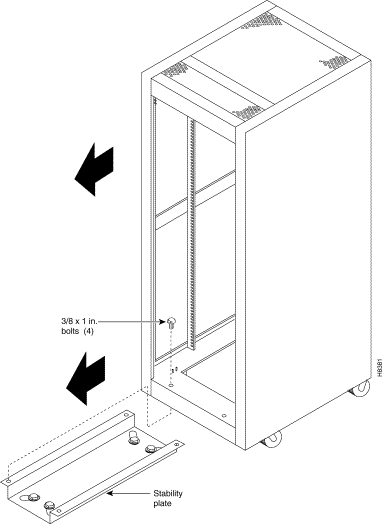
Installing an IGX 8 requires the following tools and equipment:
The installation steps consist of placing the stand-alone IGX 8 at its operational location, unpacking it, and verifying the structural and power connection integrity. Note that a stand-alone cabinet is 19.9" wide.
After the system resides at its operational location, follow the steps for connecting power. If the system has an AC power source, go to "AC Power Connections" section. If the system has a DC power source, go to "DC Power Connections" section.
The rack-mount IGX 8 fits in a 19 inch (48.25 cm.) rack with a minimum of 17.75 inches between rails. For mounting the chassis in a rack, brackets are attached to the front of the chassis. A pair of mounting brackets are attached at the back of the chassis after it is placed in the rack. Brackets for a mid-rack mounting also come with the kit.
Because of the weight of the IGX 8, StrataCom includes two temporary spacer brackets and a temporary mounting bracket to help with the installation. These pieces are removed after installation. The temporary spacer brackets stabilizes the rack, and the temporary mounting bracket together with the spacer brackets creates a partial shelf onto which the installers can slide the node. These pieces support the system while installers secure the permanent front and back mounting brackets to the rack.
 | Caution If an IGX is mounted in a cabinet, be sure an unrestricted air flow is available in and out of the enclosure. |
Step 1 Decide the IGX 8 position in the rack. See Figure 1-3 for external dimensions.

 | Caution If moving a STRATM cabinet is necessary for installing the IGX 8, do not push the cabinet at its sides. Instead, grip the cabinet at the front or back edges to maneuver it to the setup location. |
Step 2 At the front of the rack, attach the temporary spacer bracket and temporary mounting brackets so that uppermost portion of these pieces are at the bottom of the intended location of the IGX 8. See Figure 1-4 .
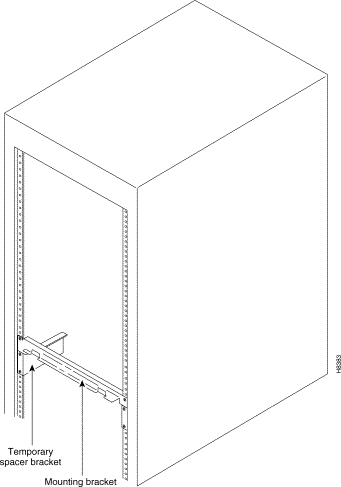
Step 3 Position the IGX 8 in front of the cabinet so that the back of the IGX card cage faces the front of the rack. If not already done, remove the foam strips from the sides, front, and back.
Step 4 Remove the attached mounting brackets (filler plates) for the stand-alone version. The mounting brackets for the rack-mount go in these places. See Figure 1-5 for the locations of the mounting brackets.
Step 5 Attach the front mounting brackets to the IGX 8.
 | Caution An IGX 8 requires a 2 or 3-person lift to put it in the rack. |
Step 6 This step requires one person on each side of the IGX card cage. Lift and slide the card cage into the rack at the front of the rack. Slide the IGX 8 to the back and rest the rear of the system on the temporary mounting brackets and spacer.
Step 7 Secure the front bracket (or mid-mount bracket) to the rack. The mid-mount brackets require the threaded rolling screws which the IGX 8 kit includes. Attach the IGX 8 to the rack with eight #10-32 machine screws.
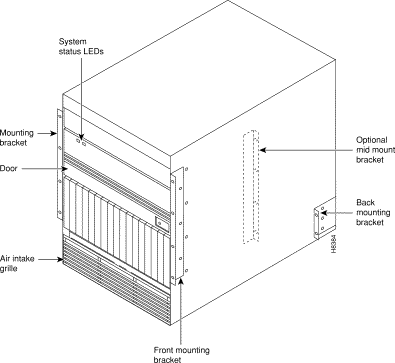
 | Caution Make sure that mounting the equipment does not create a hazardous condition due to uneven mechanical loading. The equipment rack should be securely supported. |
Step 8 Attach the permanent rear mounting brackets to the rack.
Step 9 Remove the temporary mounting brackets and temporary spacer bracket.
Step 10 If this is a DC-powered system, go to "DC Power Connections" section.
Step 11 Go to the procedures in "Readying the Cards" section.
This section introduces card placement in the IGX 8. The locations of the system cards depend on the hardware configuration. Except for the reserved slots, cards can reside in any slot on the appropriate side of the node (but StrataCom recommends that the optional ARM/ARI card set reside in slot 8). Reserved slots are for the NPMs and SCM. An NPM resides in front slot 1 and 2. The SCM must reside in back slot 1. Refer to Figure 1-7 for a front view of a shelf with 2 NPMs.
Before installing cards in the node or replacing the SCM, verify that the SCM jumpers are set properly. The two jumpers, W5 and W6, are located near the P2 connector and the strengthening bar on the SCM card. (See Figure 1-6.) For the IGX 8, connect the W5 jumper and remove the W6 jumper. Record your setting, so that you don't have to remove the SCM card later to verify the setting.
 | Caution Incorrect SCM jumper settings can cause the loss of data and services. |

 | Caution Turn off the IGX node before removing or inserting the SCM card. Damage to the node can occur if you insert the SCM card while the node is on. |
The NPM B versions require a minimum level of system software. Refer to the release notes to see if the software supports the NPM B version.
 | Warning Connector pins must align with receptacles. Before card insertion, make sure that pins are straight and that card connectors and the backplane align. Insert the card gently. It may be necessary to push the edge of the card slightly to one side for alignment (this may require removing cards). |
Most card sets support Y-cable redundancy, which requires an extra set of cards and a Y-cable. For instructions on adding redundancy, see the section for the specific card set.
The locations for the NPMs and SCMs in an IGX 8:
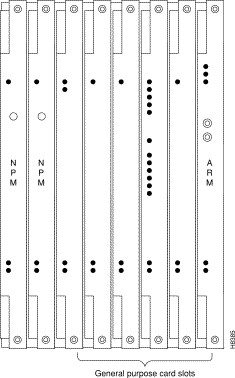
No utility buses are used because local bus communication occurs over the ACMs, so service cards can go in any unused slot. Figure 1-8 shows back card shelves in an IGX 8.
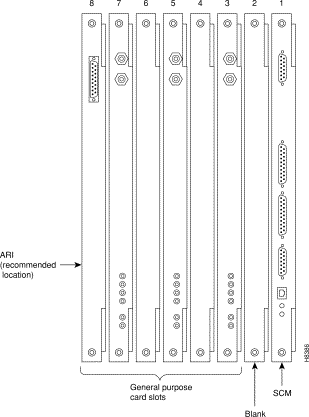
This section contains information on making connections to both the AC and DC powered systems.
 | Warning Before connecting power, make sure all IGX circuit breakers are off. |
The STRATM cabinet designed by StrataCom comes with attached studs (with hardware for securing a ground conductor to the studs) at the top and bottom of the cabinet for securing the grounding conductors. The IGX 8 housing has provisions for mounting grounding conductors on the chassis by screws. This provision is a pair of captive nuts (threaded holes) for the screws that attach the user-provided ground cable. The attachment points in the STRATM and IGX 8 cabinets are indicated by a ground symbol on the cabinet near the point of attachment. Figure 1-9 shows the STRATM cabinet with the ground attachment studs in the upper and lower parts of the cabinet. Figure 1-10 shows the location of the captive nuts and screws in an IGX 8 cabinet for securing in the ground attachments.
StrataCom recommends that the stacking order for attaching a ground conductor to the frame is for "an external tooth starwasher" to be placed first onto the stud, followed by the connector terminating the grounding conductor closed-loop ring or two-hole compression fitting, followed by "another external toothed starwasher or lockwasher," and finally a nut.
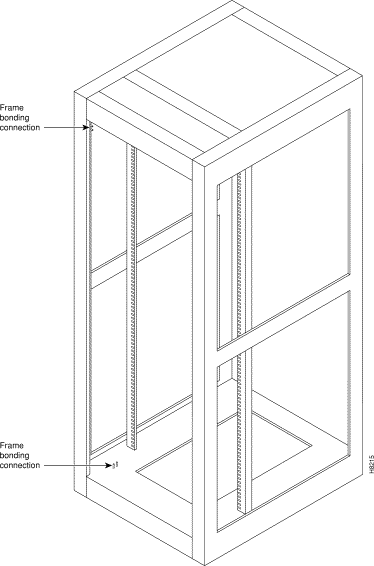
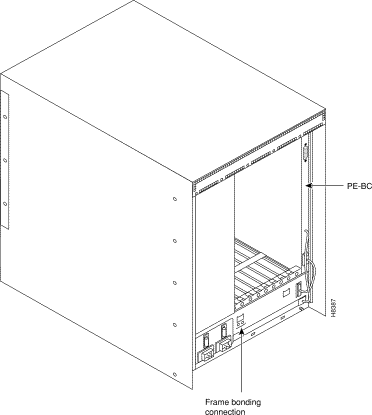
An 8 ft. (3 m.) power cord is supplied with each AC Power Supply Assembly. To make AC power connections to the IGX:
Step 1 Make sure all AC and system power circuit breakers are in the OFF position.
Step 2 Make sure the AC plug wiring has the standard relationship shown in Figure 1-11 .

Step 3 Plug the power cord into the IEC connector and tighten the screw on the clamping ring. See Figure 1-12 .
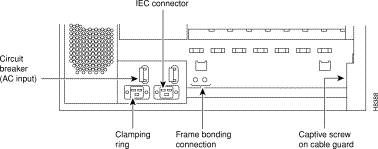
Step 4 Plug the IGX cord into a single-phase wall outlet rated for a nominal voltage between 200 to 240 VAC or 100 to 120 VAC. The outlet must also be capable of supplying 12 Amps (13 Amps in UK). The building circuit should be protected with a 15 or 20 Amp circuit breaker.
Step 5 For the dual power feed version, plug each power cord into a receptacle that connects to a separate building circuit to provide backup if one building circuit fails. Each building circuit should have a 15 or 20 Amp circuit breaker.
Step 6 The ground (green) wire of the AC power cord is connected to the IGX for safety ground. Make sure each AC receptacle in the building is grounded.
Step 7 In addition to the preceding, StrataCom recommends that an AC power strip with at least four outlets be available. Place the strip near the IGX to supply optional modems, CSU, DSUs, or test equipment. Be sure to connect this power strip to an AC source voltage that is standard for the region (for example, 115 VAC in North America or 230 VAC in Europe).
Systems that use a DC power source have one or two configurations, as follows:
Wiring is connected from one or two -48 VDC power sources to one or two DC PEMs. StrataCom does not provide this wiring. Instead, the installer or customer must supply it. These wires should be capable of carrying 20 Amps. Figure 1-13 is a wiring diagram for a redundant DC power source.
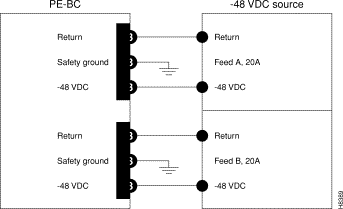
As the detailed steps on the following pages explain, installing DC power consists of attaching the three wires of the DC power source to a removable wiring block, then plugging that block into the connector on the PEM. The PEM is plugged into the PE-BC. Figure 1-14 is a view of a PE-BC out of the card cage with the PEM wired up and plugged into the PE-BC. Figure 1-14 shows a non-redundant DC power configuration. Note the blank plate that covers the unused connection.

To make a DC power connection:
 | Warning
Remember that this is a positive ground system. Ensure that polarity of the DC input wiring is correct. Under certain conditions, connections with reversed polarity may trip the primary circuit breaker and/or damage the equipment. Make sure the circuit breaker is in the OFF position. |
Step 1 For both rack-mount and stand-alone systems, the cable guard (located at the right edge of the chassis) remains off until the system is ready to power up. Remove the cable guard by loosening the captive screw at its base then swinging it away from the chassis (do this latter movement holding the top of the cable guard in place while moving the bottom of it away from the chassis).
Step 2 Insert and secure the stripped ends of the wire in the wiring block according to the scheme in Figure 1-15 and Figure 1-16 . Figure 1-16 illustrates the polarity of each connection on the pluggable terminal block. The numbers start with 1 at the bottom and go to 3. The connection at the bottom is for the -48 VDC wire. The middle wire is Safety Ground. The connection at the top is for the positive return wire (for the -48 VDC). Figure 1-16 shows the assembly with an example wire and the screw that secures it in the pluggable wire block.

Step 3 Attach the pluggable terminal block to the receptacle on the PEM.
Step 4 Loop the DC wiring through the strain relief clamp.

 | Warning For personnel safety, the green or green/yellow wire must connect to safety (earth) ground at both the equipment and at the supply side of the DC wiring. |
Step 5 Connect the DC input wiring to a DC source capable of supplying at least 20 Amps (typical). The -48 VDC power source in the building should have a 25 A DC circuit breaker. The building's wiring should include an easily accessible disconnect device. Make sure the ground wire connects to a reliable building (earth) ground.
Step 6 Leave the cable guard off until power is on.
Step 7 Before turning the system power on by moving the circuit breaker switch to the up position, check the supply voltage with a voltmeter. Use the screws at positions 1 and 3 on the pluggable terminal block as a convenient measuring point. Also, check the impedance between the safety ground (screw at location 2 on the pluggable terminal block) and the chassis. It should be close to 0.
The following sections describe how to make various IGX signal connections. The following trunk connections are supported:
The following service module connections are supported:
T1 trunk connections use the NTM8 front card and the BC-T1 back card. Japanese Y1 connections use the NTM8 front card and the BC-Y1 back card. The procedure for making Y1 connections is the same as for T1 connections described below.
Make the T1 connections as follows:
Step 1 Bring each T1 cable through the opening at the bottom of the cabinet (if applicable) and up the back of the unit.
Step 2 Use the cable management feature to help route the cables.
The T1 lines are attached to DB-15, Sub miniature, 15-pin connectors on the BC-T1 cards.
Step 1 Connect the trunks to the connectors on the BC-T1 back cards that are part of NTM8/BC-T1 card sets. Figure 1-17 illustrates a BC-T1 face plate.
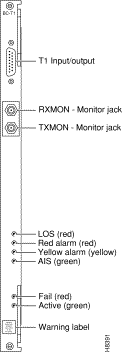
The back slot line numbers correspond to the back slot number in which the BC-T1 card resides. Record the back slot number of each line. These number are necessary for configuring the system after installation is complete.
E1 trunk connections use the NTM8 front card and the BC-E1 back card. Subrate E1 connections use the NTM8 front card and the BC-SR back card. The E1 Trunk Interface Card BC-E1 (Figure 1-18) contains the E1 trunk connector (G.703 Input/Output) that is located at the top of the back card. There are four 75 Ohm BNCs on the BC-E1 faceplate.

 | Caution Connect only equipment that complies with BS6301 to ports and monitor jacks. |
Make the E1 connections as follows:
Step 1 Bring each E1 BNC patch cable (or 15-pin cable) through the opening at the bottom of the cabinet (if applicable) and up the back of the unit.
Step 2 Connect the trunks to connectors on the BC-E1 back card that are part of a NTM8/BC-E1 card set.
Step 3 Use the cable management feature to help route the cables.
The back slot line numbers correspond to the back slot number in which the BC-E1 card resides. Record the back slot number of each line. These number are necessary for configuring the system after installation is complete.
AIT cables connect the BTM front card to a node at the back card.
The AIT back card has female BNC connectors for transmit and receive trunk connections. Use 75-ohm coax cable RG-59 B/U for short runs, AT&T 734A for longer runs. There are two per T3/E3 trunk (XMT and RCV). Cabling requirements appear in Appendix A. Figure 1-19 shows an AIT-T3 faceplate with connections and LED indicators.

The ALM (ATM Line Module) and UAI-1T3-BC (Universal ATM Interface T3 Back Card) set provide an interface for ATM traffic between user equipment and the node. This section reviews the characteristics and describes how to set up this feature. For a description of this circuit line card set, refer to the ALM description in the chapter titled "Hardware Description." The following characteristics apply to ALM:
After the ALM card has been activated, take the following steps:
Step 1 Using the cnfpln command:
Step 2 Using addcon involves neither the standard ATM class nor many of the parameters for ATM connections on a trunk. Neither cell rate policing nor ForeSight is involved. Parameter specification consists of:
After configuring the line with cnfpln, use dspplns to check configuration. The system prepends the letter "u" to the connection type to show that the connection is on an ALM. For example, "ucbr" is an ATM CBR connection on an ALM. During network operation, the dspplnutl command shows the amount of traffic and percent of utilization on the line.
The CVM8 front card works in conjunction either a BC-T1, BC-E1, or BC-J1 back card to provide channelized voice and data connections. Back card cabling is identical to that for trunk T1, E1 and J1 connections. Refer to "Making T1 or Y1 Trunk Connections" and "Making E1 or Subrate Trunk Connections" sections later in this chapter for details.
The next section describes a specialized version of data transmission service called TDM Transport. It applies to older, non-StrataCom WANs.
This section describes how to plan for use of the Time Division Multiplexing Transport (TDM Transport) feature. Note that TDM Transport requires Rev. C firmware on all connected CVMs or CDPs that use this feature. Refer to the TDM Transport description in the IGX 8 Reference Manual for details on Rev. C firmware features and limitations. Refer to the Command Reference for a description of the command parameters in related commands.
Before adding a bundled connection under TDM Transport, consider the following:
The Low-Speed Data Module (LDM) and High-Speed Data Module (HDM) front cards operate with a variety of data interface back cards to provide data connections. The LDM works with one of the LDI cards. The HDM works with one of the SDI cards.
The LDM front card works with the 4-port or 8-port version of the LDI back card for RS-232C/D (V.24) connections and with the LDI4/DDS back card for DDS (Digital Data Service) connections. The data connection ports are labeled PORT 1 through PORT 4 or PORT 1 through PORT 8. See Figure 1-20 for illustrations these back cards. For instructions on configuring an LDI port for DTE or DCE mode, refer to the forthcoming section titled Configuring the Mode of an LDI Port.
The HDM front card works with an SDI back card. Four types of SDIs are available. These are V.35, RS-449/422, RS-232D, and RS-232C (V.24)—X.21 requires RS-449 plus an adapter cable. Each type of SDI has four connection ports, which are labelled PORT 1 through PORT 4. An example SDI card appears in Figure 1-20 .

When attaching data lines to the SDI, LDI, and DDS ports, use the shortest reasonable length of cable to reach each port.
The factory-set, default mode of an SDI port is DCE. (Although this is the default, verify it before starting up the system. See step 1, below.) For the two modes, the rows on the back card jumper connector that are occupied when the jumper card is in place are as follows:
To change the mode on a port to DTE, position the jumper board for that port as follows:
 | Caution To prevent damage to the SDI cards, wear a wrist strap and clip the strap to the enclosure. |
Step 1 At the back of the IGX, remove the SDI card, as follows:
Step 2 Move the jumper board one row of pins away from the SDI faceplate (Figure 1-21 ). For DTE mode, the jumper board should occupy rows 2, 3, 5, and 6.
If a port is in DTE mode and needs to be changed to DCE, plug the jumper board into the connector receptacle pin rows closest to the SDI faceplate (Figure 1-21 ). These rows are 1, 2, 4, and 5.

Optional redundancy for HDM and LDM cards can be provided with a second front and back card set and a Y-cable connection on each port to the customer data equipment, as Figure 1-22 shows. (The arrangement for HDM and LDM card groups is the same.)
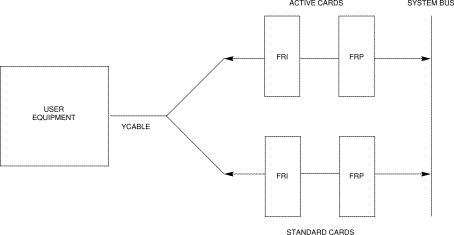
Each port on an LDI card uses an adapter cable. For a list of LDI adapter cables, refer to Appendix A, "Standard IGX Cables." Each cable does the following:
See Figure 1-23 for an example. In Figure 1-23, the adapter cable makes the port a DCE port. Circuits on the card check identifying pins on the cables and configure the ports as DTE or DCE.

Four types of frame relay interfaces are available:
The T1 line terminates on the FRI-T1 card to a DB15 sub miniature connector. The FRI card has a female connector. A BNC type connector is used for the unbalanced connection.
The FRI-E1 card provides for a 75-ohm unbalanced coax line termination or a balanced 120-ohm twisted pair termination. A DB15 connector is used for the balanced connection. The FRI card has a female connector.
The V.35 connection uses a standard 34-pin female MRAC type connector with a standard V.35 cable.
The FRI-X.21 has female DB15 sub-miniature connectors.
The cabling requirements for the different frame relay interfaces appear in Appendix A.
Optional redundancy on a frame relay port can be provided with a second FRM/FRI card set and a Y-cable connection on each port to the customer data equipment. The instructions in the forthcoming "Setting Up a Frame Relay Port " section include setup information on redundancy. The card redundancy kit for this purpose contains a second FRM/FRI card set, four Y-cables to interconnect the two card sets to the customer connection, and a 200-Ohm DCE/DTE jumper board for the installed FRI. In the case of either a V.35 or X.21 interface, the DCE/DTE daughterboard on the FRI must be changed when a non-redundant card set is changed to a redundant card set. Only the model D of the V.35 or X.21 back cards use the daughterboard.
Y-cable redundancy is not possible between inconsistent back card types, such as FRI T1/E1 to FRI V.35. The screen display for the dspyred command shows a back card conflict with a configured interface in reverse video. (Refer also to the descriptions of the upcln and upfrport commands in the Command Reference.) Inserting a front card that does not support the number of upped ports is flagged by displaying the front card in reverse video on the Y-Cable Redundancy Screen.
After the hardware is installed, the node must be reconfigured to indicate that the slot is equipped with redundancy. Use the Add Y Redundancy (addyred) command to do this. Refer to the Command Reference for more information on the commands addyred, delyred, dspyred, and ptyred.
Installation of the FRI-X.21 or FRI-V.35 follows the same steps as other IGX back cards. It can be installed in any back slot except slot 1 (reserved for the SCM).
The four ports on the FRI-X.25 are equipped with female DB15 sub miniature connectors. The four ports on the FRI-V.35 are equipped with female, 34-pin MRAC connectors. Each port may be configured as a DCE or as a DTE by selecting the position of a jumper board mounted on the FRI.
 | Warning Only qualified personnel should open the cabinet door. |
 | Caution To prevent damage to the FRI cards, ground yourself before handling IGX cards by clipping a grounding strap to your wrist, and clipping the wrist strap lead to the enclosure. |
The factory-set, default mode of an FRI port is DCE. (Although this is the default, verify it before starting up the system. See Step 1, below.) For the two modes, the rows on the back card jumper connector that are occupied when the jumper card is in place are as follows:
If an interface mode need changing, reposition the jumper board for the port as follows:
Step 1 At the back of the IGX cabinet, identify the slot number of the FRI card.
Step 2 Loosen the captive mounting screws on both ends of the faceplate.
Step 3 Operate the card extractor levers and slide the card out.
Step 4 For each port that is being changed to DTE, move the jumper board one row of pins away from the FRI faceplate (Figure 1-24). For DTE mode, the jumper board should occupy rows 2, 3, 5, and 6.
If a port is in DTE mode and needs to be changed to DCE, plug the jumper board into the connector receptacle pin rows closest to the FRI faceplate (Figure 1-24). These rows are 1, 2, 4, and 5.
Step 5 Re-insert the FRI card and gently slide it in all the way to the rear of the slot.
Step 6 Screw in the mounting screws.

This section describes the steps for setting up a frame relay port after hardware installation and system startup. Setting up a frame relay port is done at the IGX control terminal or StrataView Plus workstation. For details on each command in the steps that follow, refer to the Command Reference.
Step 1 Verify that the nodes at each end of the connection have the correct FRI back card and FRM8 front card. Use the Display Cards (dspcds) command. The output of this command shows the shelf and slot of each card. Make a note of each position.
Step 2 Check the port types (DCE or DTE) using the Display Frame Relay Port (dspfrport) command for the slot used by the FRI/FRM8. A jumper board determines whether the port operates in DCE mode (the default) or DTE mode.
Step 3 If a redundant card is used, configure the card pair for redundancy by using the Add Y-Cable Redundancy (addyred) command for this slot.
Step 4 Configure the port for speed, clocking, LMI type, and so on, by either configuring the parameters with the Configure Frame Relay Port (cnffrport) command or using the default parameters. Set the Port ID to the DLCI assigned to this end of the connection (required if using bundled connections, optional otherwise).
Step 5 Prior to activating a port on either a T1 or E1 line, the port must be added (addfrport). Because V.35 and X.21 connections are not channelized, adding the port for these interfaces is not necessary.
Step 6 Activate the port using the Up Frame Relay Port (upfrport) command.
Step 7 Specify a frame relay class. Two approaches are available. Pre-specified classes are available. Otherwise, the Configure Frame Relay Class (cnffrcls) command can specify the class. To see the pre-specified classes, use the Display Frame Relay Classes (dspfrcls) command then select an appropriate class for the connection.
Step 8 If a connection was not added in the last step by using a pre-specified frame relay class, add the connection to the network by using the Add Connection (addcon) command. Enter the slot address and DLCI for each end of the connection.
Step 9 Configure the connection parameters using the Configure Frame Relay Connection (cnffrcon) command, or use the defaults. If ForeSight is available, enable it now.
Step 10 Setting the channel priority using the Configure Channel Priority (cnfchpri) command is an option at this time. Typically, the priority that the system automatically sets is sufficient.
When a port has multiple PVCs, the option of bundling or grouping the connections is available. Bundling facilitates meshing. Grouping helps conserve system resources such as device codes and logical connections in networks that need a high level of standardization.
Step 1 For grouping connections, first establish a connection group with the Add Connection Group (addcongrp) command. (The Display Connection Group (dspcongrp) command displays existing groups.)
Step 2 Group connections using the Group Connection (grpcon) command.
Step 3 Connections are bundled during parameter specification in the Add Connection (addcon) command for frame relay: when the Return key is pressed without a DLCI during port specification, prompts appear for bundling connections. Refer to the "Frame Relay Connections" chapter in the Command Reference.

The types of FastPAD interfaces are T1, E1, V.35, and X.21.
FastPAD connections use the FTM front card and an FPC backcard. The back card versions are FPC T1, FPC E1, FPC V.35, and FPC X.21.
The T1 card has a DB15 for RX/TX. The E1 connections are the same except for additional BNC connectors for unbalanced connections and BNC connectors for RX/TX MONITOR.
A V.35 connection uses a standard 34-pin female MRAC-type connector with a standard V.35 cable. The FPC-X.21 has female DB15 sub miniature connectors.
The cabling requirements are the same as for the corresponding frame relay interface and are detailed in Appendix A.
Installation of the FTM/FPC card set follows the same steps as other card sets. The FPC plugs directly into the FTM card. The FTM and FPC can reside in any slot not reserved for the NPM and SCM, respectively.
Each of the four ports on the FPC V.35 and X.21 versions can be configured as a DCE or as a DTE by selecting the position of a jumper board on the FPC. These ports are factory-configured as DCE interfaces. (Although the default is for DCE, check the boards before starting up the system.)
 | Caution To prevent damage to the FTM and FPC, put on a ground strap and clip the wrist strap lead to the enclosure. |
To change a port's interface configuration on the FPC V.35 or FPC X.21, reposition the jumper board for the port as follows:
Step 1 At the back of the IGX cabinet, identify the slot where the FPC card resides.
Step 2 Loosen the captive phillips screws at both ends of the faceplate.
Step 3 Rotate the card extractor levers and slide the card out.
Step 4 For each port that is being changed to DTE, move the jumper board to the row of connector pins that is one row away from the FPC faceplate. Figure 1-26 shows positions for both DTE and DCE.
Step 5 To change a port to DCE, plug in the jumper board so that the row of connector pins that is closest to the FPC faceplate is occupied. See Figure 1-26.
Step 6 Re-insert the FPC card and gently slide it in all the way to the rear of the slot.
Step 7 Screw in the mounting screws.

To install an ARM card set, proceed as follows:
Step 1 At the back of the IGX, identify the slot where the ARI card is to reside.
Step 2 Install the ARM in the front slot and use the card extractors to help secure card.
Step 3 Install the ARI in the corresponding back slot. Use the extractor handles to help secure the card then tighten the captive screws by hand.
Step 4 Note that the FAIL LED on the ARM is off. The ACTIVE LED is also off.
Step 5 Attach a 22 or 24-gauge cable with the appropriate number of pairs to a male DB37 connector at one end. Typically, a 12-pair cable is adequate. Connect this cable to the DB37 connector on the ARI and tighten the captive screws.
See also "Initial Startup of the IGX," when the system is ready for power.
The steps that follow show how to set up an ARM card set after the physical installation is complete. This is done from the IGX control terminal or StrataView Plus workstation. For details on each command used, refer to the Command Reference.
Step 1 Verify that the node is equipped with the proper ARM front card and ARI back card by using the Display Cards (dspcds) command. This will show in which slot they are located.
Step 2 From a control terminal or a StrataView Plus NMS workstation, vt to the node and enter the addalmslot command followed by the slot number where the ARM is located. This will activate the alarm reporting from the card.
Step 3 Observe that the ACTIVE LED on the ARM card is on.
Step 4 Testing the operation of the alarm outputs involves creating an alarm and noting the corresponding alarm output. This test is easy on a node that is not connected to the network but not on a node that is part of a fully operational network. The best time to create a major alarm is during a low traffic period. If this is performed, proceed with Step 5. Otherwise, stop here.
Step 5 Create an alarm by disconnecting a trunk cable from the connector on a back card.
Step 6 Observe that there is a MAJOR LED lit on the front of the ARM.
Step 7 Using a voltage/ohm meter (VOM), make sure continuity exists between pins 16 and 17 and between pins 35 and 36 at the DB37 connector on the ARI card.
Step 8 Reconnect the cable that was disconnected in Step 5.
Step 9 With the VOM, check that the reading between pins 16 and 17 and pins 35 and 36 are open and the MAJOR LED is not on.
Alarm output connections are made to the DB37 connector on the ARI card. The connector pin assignments with the alarm signal names are called in the table that follows (see also Appendix A).
| Pin # | Alarm Type | Alarm Name | Alarm Description |
|---|---|---|---|
1 | both | CHASSIS | Protective ground |
3 | Network | NWMAJA | Major—normally open contact |
22 | Network |
| Major—normally closed contact |
4 | Network | NWMAJC | Major—common contact |
10 | Node | MNVISA | Minor Visual—normally open contact |
11 | Node |
| Minor Visual—normally closed contact |
12 | Node | MNVISC | Minor Visual—common contact |
16 | Node | MJAUDC | Major Audible—common contact |
17 | Node | MJAUDA | Major Audible—normally open contact |
23 | Network | NWMINA | Minor—normally open contact |
24 | Network |
| Minor—normally closed contact |
25 | Network | NWMINC | Minor—common contact |
29 | Node | NWAUDA | Minor Audible—normally open contact |
30 | Node |
| Minor Audible—normally closed contact |
31 | Node | NWAUDC | Minor Audible—common contact |
35 | Node | MJVISC | Major Visual—common contact |
36 | Node | MJVISA | Major Visual—normally open contact |
Table 1-2 shows the unassigned connector pins.
Pin # | Alarm Type | Alarm Description |
|---|---|---|
7 | Relay 2 | common contact |
8 | Relay 2 | normally closed contact |
9 | Relay 2 | normally open contact |
26 | Relay 4 | common contact |
27 | Relay 4 | normally closed contact |
28 | Relay 4 | normally open contact |
The DB-15 connector labeled Ext Clocks on the faceplate of the SCM connects two external sources for a high-stability clock (primary and redundant). One of the trunk or circuit line inputs can also serve as a source of timing for the node. If you do not select a clock source, the node uses the internal IGX clock as the clock source.
Two separate clock inputs exist, and can be used simultaneously on the IGX. They are labelled External-1 and External-2. Both clock inputs require an EIA/TIA 422 balanced square wave signal at either 1.544 or 2.048 MB per second.
The connector pinouts are described in Appendix A.
A network must have at least one control terminal (or StrataView Plus workstation if you wish to collect statistics) attached, along with a network printer for printing out the status of the system. The SCM has three ports for attaching peripherals to an IGX. These ports are CONTROL TERMINAL, LAN AUI, and AUX PORT.
For StrataCom ISC to perform remote troubleshooting, a modem must connect to the network. This is a requirement for all StrataCom service plans. The following sections provide procedures for attaching peripherals to the IGX. Be sure to read the manufacturers' literature to ensure that the equipment is ready before attempting to connect it to the IGX.
To use network management, at least one node in a StrataCom network running Release 7.2 software must have a StrataView Plus workstation connected. The workstation connects to the AUI Ethernet LAN port on the SCM.
The StrataView Plus workstation may be used to configure and maintain all nodes in a network. For instructions on using the StrataView Plus workstation, see the StrataView Plus Operations Manual.
If only a single NMS station is to be connected and the network is relatively small, a serial RS232 port, the CONTROL TERMINAL port, may be used.
Appendix A lists the control terminals supported by the IGX 8 and the configuration settings. Appendix A lists the pin assign-ments for the IGX 8 control terminal port.
Attach the control terminal to the SCM as follows (see Figure 1-27).
Step 1 From the back of the cabinet, run the control terminal RS-232/V.24 cable through the opening at the bottom and up to the SCM card in back slot 1.
Step 2 Locate the CONTROL TERMINAL connector on the SCM and attach the control terminal RS-232/V.24 cable to it.

Step 3 Tighten the RS-232 connector screws to firmly attach the cable to the CONTROL TERMINAL connector.
Step 4 Plug the control terminal power cord into the appropriate wall receptacle.
Step 5 Set the port function for VT100 (#5) using the cnftermfunc command.
Step 6 Make sure the AUXILIARY port and the terminal are set to the same baud rate and check the other communication parameters using the cnfterm command.
If the network is large or extensive network statistics are needed, an Ethernet port (LAN port) should be used. Larger networks produce a greater flow of statistics data between the node and the StrataView Plus workstation, so a higher speed Ethernet port is suitable. Figure 1-28 illustrates this connection. Accessing a node over an Internet connection requires the operator to use cnflan to enter the Internet Protocol (IP) address, IP subnet mask, TCP service port, and gateway IP address.

Step 1 Contact a System Administrator to obtain IP addresses for the workstation and for the IGX node.
Step 2 Normally, the System Administrator updates the NIS database, as applicable (if an NIS is used), and adds the IP addresses for the workstation and node to the NIS database. Refer to the StrataView Plus Operations Manual for instructions on configuring the StrataView Plus workstation.
192.187.207.200 hedgehog 192.187.210.30 sanfranStep 3 Configure the LAN port on the IGX node using a dumb terminal or an RS-232 connection via the workstation (using the vt command, as applicable) to enter the appropriate cnflan parameters.
The cnflan command configures the node's communication parameters so that the node can communicate with a StrataView Plus terminal over an Ethernet LAN using the TCP/IP protocol. The parameters contain address information about the Ethernet TCP/IP network that is used to connect the StrataView Plus workstation to an IGX node. The values used must conform to those of the network and should be supplied by the Ethernet network administrator.
The cnflan command has the following parameters:
A cnflan screen is shown in Figure 1-29 . The active IP address for the workstation has been entered as the IP address selected previously for the node, 192.187.207.21. The IP Subnet mask is entered as 255.255.255.0 for a Class C LAN network. The TCP service port is entered as 5120. Since the workstation and node are on different networks in this example, a gateway address of 192.187.207.1 has been entered. If the workstation and node are both on the same network, no gateway address is needed. The "Maximum LAN Transmit Unit" and "Ethernet Address" parameters are not configurable by the cnflan command. The "Ethernet Address" is a hardware address ("burned into the NPM card") that is unique to each NPM card.
D2.cb1 LAN StrataCom IGX 8 8.2 Feb. 27 1996 14:23 PST
Active IP Address: 192.187.207.21
IP Subnet Mask: 255.255.255.0
TCP Service Port: 5130
Default Gateway IP Address: 192.187.207.1
Maximum LAN Transmit Unit: 1500
Ethernet Address: 00.55.43.00.04.55
Control Socket - Ready
Base Socket Descriptor - 1
Socket Closed
Last Command: cnflan
Next Command:
Step 4 Connect the StrataView Plus workstation and the IGX node to a LAN network. Examples are shown in Figure 1-30 and Figure 1-31. The LAN port on the IGX node provides a DB-15 connector that can be connected to a Y-cable which in turn is connected to an AUI as shown in Figure 1-31.
Step 5 To test that a LAN connection to the IGX LAN port is good, an example hostname of "sanfran" entered in the config.sv file, enter the following at the StrataView Plus workstation:
ping sanfran
Step 6 Once the workstation and IGX node interface has been set up, StrataView Plus can be started. Figure 1-32 shows the dsplan screen after StrataView Plus has been started and the communication sockets are active.


D2.cb1 LAN StrataCom IGX 8 8.2 Feb. 27 1996 14:27 PST
Active IP Address: 192.187.207.21
IP Subnet Mask: 255.255.255.0
TCP Service Port: 5130
Default Gateway IP Address: 192.187.207.1
Maximum LAN Transmit Unit: 1500
Ethernet Address: 00.55.43.00.04.55
Control Socket - Ready
Base Socket Descriptor - 1
Open Socket Descriptor - 2
Last Command: dsplan
Next Command:
 | Caution Before switching on the StrataView Plus workstation, refer to the StrataView Plus Operations Guide. |
Step 7 Switch on the control terminal (or StrataView Plus workstation). Adjust the terminal's configuration, if necessary, to match the default settings of the control terminal port in the IGX. See Appendix A, "Peripherals Specifications," for the required settings. See the StrataView Plus Operations Guide for settings and operating instructions for the workstations.
When a network management station has more than one serial port, ports may connect to different networks. When the number of workstation serial ports is less than the number of networks to be managed, a terminal server is necessary to obtain a communications link to the separate networks. This subject is covered in the StrataView Plus Installation Guide.
At least one node in the network should have a printer connected. The printer connects to the AUX PORT on the SCM.
The printer is used to display information about network operation. It can be configured to print maintenance information on a regular basis, and it can print specific diagnostic information when necessary. Instructions on using the printer for this purpose are in the Command Reference (see Appendix A in the Command Reference for a list of printer-related commands).
Attach the printer to the IGX as follows:
Step 1 Check the printer RS-232/V.24 cabling pinout and, if required, adjust the DIP switches to the settings indicated for the type of printer to be connected to the IGX. See Appendix B for RS-232/V.24 cable pinout and DIP switch settings.
Step 2 At the back of the cabinet, run the printer RS-232/V.24 cable through the opening at the bottom and up to the SCM card in back slot 1.
Step 3 Locate the AUX PORT connector on the SCM and attach the printer RS-232/V.24 cable to it. See Figure 1-33 .

Step 4 Tighten the RS-232/V.24 connector screws to firmly attach the cable connector to the AUX PORT connector.
Step 5 Plug the printer power cord into the appropriate wall receptacle.
Two modems may be connected to the IGX in order to provide access for remote troubleshooting and for remote alarm logging (see Figure 1-34). Each connection between the SCM and a modem requires a special cable and setup procedure. Refer to Appendix A for instructions on connecting and setting up the modems.
The modem that is used to provide access for remote troubleshooting from the StrataCom International Support Center (ISC) office (ISC-to-IGX modem) is connected to CONTROL TERMINAL port on the SCM. Typically, the modem connects to the telephone wall jack with a direct-dial line.
The modem that is used to provide remote alarm logging (IGX-to-ISC modem) is connected to the AUX PORT on the SCM. This modem connects to a wall jack using a standard telephone line.

This section describes checkout procedures to follow after the hardware is in place and ready to receive power. "IGX Configuration Summary ," summarizes the steps and lists the commands for brining up the system.
Before using the IGX, check that the following procedures have been performed:
Step 1 The IGX unit using AC facility power is plugged into an appropriate AC receptacle. The IGX unit using DC facility power is connected to an appropriate, dedicated DC source.
Step 2 The full complement of cards for the specific node are mounted in the correct slots, correctly seated, and locked.
Step 3 The T1 connections are attached to the appropriate BC-T1 faceplate.
Step 4 The E1 connections are attached to the appropriate BC-E1 faceplate.
Step 5 The Fractional E1 or T1 connections are attached to the BC-E1 or BC-T1 card connector, if the IGX is used to provide Fractional E1 or T1 service.
Step 6 The Subrate connections are attached to the BC-SR card connector if the IGX is used to provide Subrate E1 or T1 service.
Step 7 The data connections are attached to the appropriate SDI/LDI cards.
Step 8 The Frame Relay User Device Connections are attached to the appropriate FPC card connectors.
Step 9 A control terminal is connected to the CONTROL TERMINAL port on the SCM in back slot 1, or a StrataView Plus workstation is plugged into the AUI port, and the power cord plugged into the appropriate AC receptacle.
Step 10 If specified, a printer connects to the AUX PORT on the SCM in back slot 1, and the power cord is plugged into the appropriate AC receptacle.
Step 11 If specified, one or more modems connect to the CONTROL TERMINAL port or AUX PORT, as applicable, on the SCM in back slot 1, and any modem power cords plug into the appropriate AC receptacle.
Step 12 At the back of the unit, turn the circuit breakers to the ON position. The circuit breakers are located either on the back of the power supply tray in a system using an AC source or the Power Entry Module (PEM) in a system using a DC source. After initial power-up, DC systems can be switched off and on either at the PEM or at the building site's resident circuit breaker. Use the building's DC circuit breaker only if all cables are clearly marked; if the building's dedicated circuit breaker has an actual switch and not just a fuse; and if controlling power at the building's circuit breaker actually provides an advantage over removing the cable guard.
Step 13 Observe that, after the IGX node switches on, the cards go through a series of initial diagnostic self-tests.
Step 14 If an alarm exists for a T1 or an E1 line that is physically connected to the IGX, try reconnecting the line to make sure there is a good physical connection. If the alarm condition continues, a valid T1 or E1 problem may exist.
The IGX software contains a group of diagnostic tests that run on the system's hardware at power-up. The startup diagnostic either passes or fails the NPM(s). The test result is displayed on the control terminal screen as pass or fail (Figure 1-35 or Figure 1-36).
**************************************************************************************
Release 7 Boot power up diagnostics starting.
68000 Internal Registers test passed.
68000 clock test passed.
Static RAM test passed.
TDM memory test passed.
Fast RAM test passed.
BRAM test passed.
Dynamic RAM test from Hex Address 400000 to Hex Address 9FFFFF
Release 7 Power up diagnostics complete.
**************************************************************************************
**************************************************************************************R
elease 7 Boot power up diagnostics starting.
68000 Internal Registers test passed.
68000 clock test passed.
Static RAM test passed.
TDM memory test passed.
Fast RAM test passed.
BRAM test failed.
Remove and reinsert this NPM to see if it fails again.
**************************************************************************************
If an NPM fails the power-up diagnostic (Figure 1-36), it does not boot. When this happens, do the following:
Step 1 Remove the failed NPM from its slot.
Step 2 Install the NPM in the same slot again.
Step 3 Wait for the power-up diagnostic to run.
Step 4 If the NPM fails the power-up diagnostics again, replace it with an NPM that is known to be good. For card replacement procedures, refer to Chapter 1.
IGX software includes internal diagnostic routines that periodically test the cards' performance. These self-test diagnostics automatically start and run in background. They do not disrupt normal traffic. If a failure is detected during the self test, the faceplate red FAIL LED is turned on. The operator can also view the status at the control terminal by executing the Display Card (dspcd) command.
A report of a card failure remains until cleared. A card failure is cleared by the Reset Card (resetcd) command. The two types of resets are hardware and failure. The reset failure clears the event log of any failure detected by the card self-test but does not disrupt operation of the card. A reset of the card firmware is done by specifying a hardware reset. This reboots the firmware and momentarily disables the card. If a redundant card is available, the hardware reset causes a switch over to the standby card.
Check the status lights on the system unit cards. Table 1-3 shows the normal status of each light, assuming n+1 redun-dancy for NTM8 and CVM8 cards
| Card | Active Status | Standby Status1 | Alarms |
|---|---|---|---|
NPM | 1 | 1 | - |
CVM8 | - | - | - |
NTM8 | - | all | - |
BC-T1/E1 | - | all | - |
BC-SR (Subrate) | - | all | - |
AIT-T3/E3 | - | all | - |
HDM/LDM | - | all | - |
SDI/LDI | - | all | - |
FRM8 | - | all | - |
SCM | 1 | 0 | - |
BTM | - | all |
|
ARM | 1 | -- | - |
Power Supplies | All | - | - |
| 1Standby status is indicated by no lights on. |
The means for verifying the correct power supply voltages are the DC Okay and AC Okay LEDs on each power supply. If either of these LEDs is off, a problem exists in relation to that supply. Power supplies are not field-adjustable. If a power supply voltage is out of tolerance, replace the supply with one known to be within tolerance. Refer to the "Replacing an AC Power Supply" section and procedure in Chapter 1.
This section outlines the steps and names the commands for configuring a network. This section is not an exhaustive presentation. For detailed descriptions of the commands, refer to the Command Reference. For detailed descriptions of the networking concepts, refer to the System Manual.
IGX 8 configuration is done via commands entered at the control terminal. Management of the IGX 8 is done via the StrataView Plus Network Management Station. Note that, for the purpose of using the Command Reference, IPX and IGX commands are the same. (However, not all uses of commands that run on the IPX actually apply to the IGX.)
For IGX configuration, the control terminal can have system access through a local control port (over an RS-232 or Ethernet TCP/IP link) or from a control terminal screen on a StrataView Plus Network Management Station (NMS). Remote control terminal access is possible using a Virtual Terminal (vt) command if the node has been configured with a name (cnfname), and at least one trunk to the network has been established.
The basic tasks to configure an IGX are as follows:
Two approaches are available for establishing a frame relay-to-ATM interworking connection in a tiered network (see the System Manual for a description of tiered networks). The simplest approach is to use the Connection Manager in StrataView Plus. When the connection to an FRSM on an AXIS interface shelf is specified, the correct end-to-end connection type is established. This connection type is either atfr (ATM-to-frame relay interworking) or atfst (ATM-to-frame relay interworking with ForeSight). The other approach is to use the command line interface on the IGX 8 or other routing node to execute addcon and related commands (such as cnfcon) to establish the connection between routing nodes. A network interworking connection requires that each connection segment be specified. (Establishing the connection between the FRSM on the AXIS shelf and the BPX requires execution of the addchan command.)
You can monitor, manage, and troubleshoot the IGX using the StrataView Plus Network Management Station. Issue commands to an IGX node through the Node Administration window. Display and monitor the network's topology using the Network Overview and Network Topology windows. Alarms are reported and logged into the Event Log window. Statistics are collected and displayed through the SV+ Statistics window.
![]()
![]()
![]()
![]()
![]()
![]()
![]()
![]()
Posted: Mon Nov 18 14:10:28 PST 2002
Copyright 1989-2000©Cisco Systems Inc.